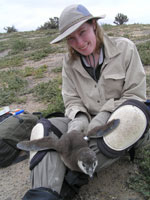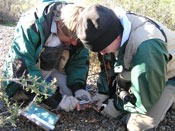 |
|||||
| Biology Home Page | News | Calendar | Make a Gift | |||||
|
Fall 2008 | Return to issue home
Magellanic Penguin Conservation By Kristy Brady
In 1999 Argentina’s primary fishery, hake, collapsed due to rampant overharvesting. Since then many fishing fleets previously harvesting hake have transferred their efforts to anchovies, resulting in anchovy harvests larger than have been seen in decades. Bewilderingly, the government of Argentina has supported expanding anchovy fishing efforts using the very same model that drove the hake fishery defunct. Anchovies are largely used as fishmeal and oil. That is, they are not necessarily eaten directly by humans, but ground up and used in feed for fish farms or agriculture. In the ocean anchovies are a critical component of the food web eaten by many species including tuna, penguins, dolphins, and sea lions. In a Science publication last year, Biology graduate student and ARCS Fellow Elizabeth Skewgar, Biology Prof. Dee Boersma, and two Argentinean colleagues warned that if the anchovy fishery collapses, undue harm to the plethora of species that rely directly and indirectly on anchovies for survival could be expected to follow. And the decline of many of the more charismatic of these species, including Magellanic penguins, would likely result in the ruin of a now thriving ecotourism industry along coastal Argentina.“I think about penguins swimming in the ocean,” Elizabeth Skewgar said. “A lot.” For her dissertation, Elizabeth is researching how Magellanic penguins spend their time in the ocean. An adult penguin’s life can be simplified into two parts: breeding and winter migration. The one significant difference between breeding and winter migration is chicks. While breeding, penguins are “central-place foragers.” That is, they go on foraging trips and always return to a central place, their nest. During winter migration, adult penguins do not have any nestlings; therefore, it is not necessary for them to return to the nest after foraging. This makes winter migration behavior much less predictable than central-place foraging behavior. Central-place foraging behavior in Magellanic penguins is well studied. Elizabeth’s Ph.D. advisor Dee Boersma has tracked a dozen penguins every year for over a decade in order to characterize foraging behavior during the breeding season. However, behavior during winter migration has not been studied as extensively, so is less understood. For the past few years Elizabeth has been tracking penguins during winter migration to determine how they divide their time at sea between swimming to food sources (e.g., a school of anchovy) and eating.
Penguins are tracked at sea using satellite telemetry. Small transmitters fastened to their backs communicate with satellites that pass overhead about twelve times a day. With each satellite pass, there is a window of 10-15 minutes when the satellite can receive a signal from the transmitter. The transmitters are outfitted with a saltwater switch so that they cannot transmit a signal while underwater. Transmitting a signal to a satellite is energy intensive, so this feature reduces the amount of necessary battery power and hence the overall transmitter pack size. This is important because an oversized pack will add too much drag to the penguin and detrimentally affect its swimming and foraging capabilities. The data received from the satellite are latitude, longitude, and time. “Essentially,” Elizabeth explained, “we get a bunch of dots on a map. But what do those dots mean? What was the bird doing at that point? This is the question we’re trying to answer.” To make sense of the data, Elizabeth worked with UW Oceanography professor Daniel Grünbaum to build mathematical models that quantify how fast a penguin is moving and how straight its path is. Depending on these parameters, the model identifies the penguin as either “in transit” or “foraging”. A fast and straight path indicates a penguin in transit to food, while a slower, zigzagging path describes a foraging penguin. Such data are important for understanding how a penguin is spending its time and hence its energy. The farther away a penguin has to swim to reach a food source, the more energy it will have to spend getting there. Increased distances to food or more time spent foraging can ultimately lead to lower weight penguins and weight for a penguin is important for storing energy and reproducing successfully. The penguin behavior model that Elizabeth and colleagues developed and the central-place foraging behavior model are powerful tools that will enable scientists to determine if penguins begin to travel farther to find food or have to spend more time foraging because of diminished prey populations caused in part by overharvesting of their primary food source, anchovy. Such knowledge gathered early on would inform researchers of impending crises and permit them time to take action to prevent populations from crashing. Biology professor Dee Boersma has been studying Magellanic penguins in Argentina for nearly 30 years, supported by funding from a variety of sources including the Wadsworth Endowment for Conservation Science and the Wildlife Conservation Society. Extensive studies of natural populations are relatively rare, but afford invaluable insight into how populations fluctuate over time. This long-term scrutiny puts the Boersma lab in a prime position to document how recent increases in anchovy fishing, as well as changes in other critical factors such as climate, will impact Argentina’s Magellanic penguin populations. To learn more about Magellanic penguin research being conducted by the Boersma lab and how you can help support it, visit their Web site. Fall 2008 | Return to issue home | |||||
|
|||||


